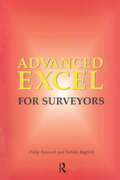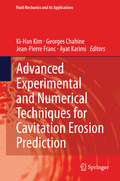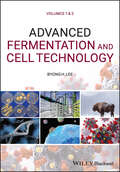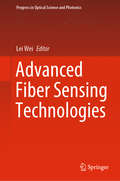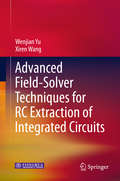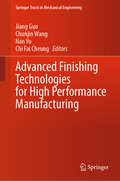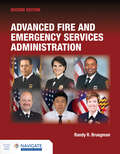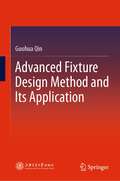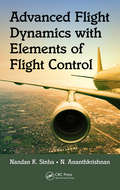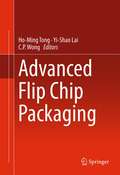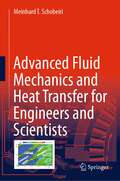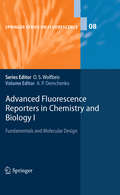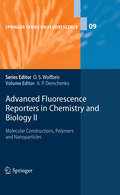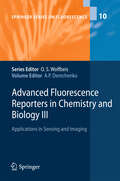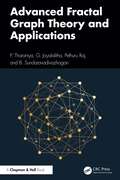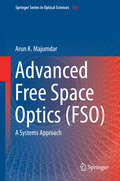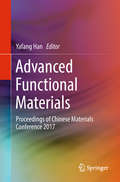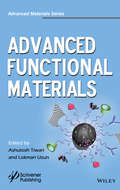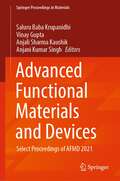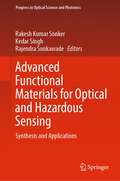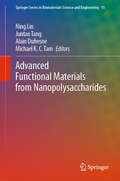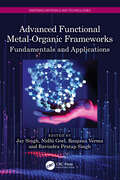- Table View
- List View
Advanced Excel for Surveyors
by Philip Bowcock Natalie BayfieldAdvanced Excel for Surveyors is the companion to the highly successful Excel for Surveyors. This volume is intended to help both students and practitioners use Mircosoft Excel™ to solve some of the more complex problems that the surveyor may come across.It explores how Visual Basic and macros can simplify and speed up repetitive tasks, fulfilling one of the basic aims of computing: “If it is repetitive teach the machine to do this for you”. The methodology of portfolio analysis is a relatively new discipline, which may be unfamiliar to many readers. The book provides an introduction to the principles and shows how Excel can help, readers may even find this of help when assessing their own personal investment portfolios. Further ideas for setting up databases; how to arrange for several surveyors to work on a single project; data analysis; and the use of charts in Reports are discussed together with further advice on security and protection.
Advanced Experimental and Numerical Techniques for Cavitation Erosion Prediction (Fluid Mechanics and Its Applications #106)
by Ki-Han Kim Georges Chahine Jean-Pierre Franc Ayat KarimiThis book provides a comprehensive treatment of the cavitation erosion phenomenon and state-of-the-art research in the field. It is divided into two parts. Part 1 consists of seven chapters, offering a wide range of computational and experimental approaches to cavitation erosion. It includes a general introduction to cavitation and cavitation erosion a detailed description of facilities and measurement techniques commonly used in cavitation erosion studies, an extensive presentation of various stages of cavitation damage (including incubation and mass loss) and insights into the contribution of computational methods to the analysis of both fluid and material behavior. The proposed approach is based on a detailed description of impact loads generated by collapsing cavitation bubbles and a physical analysis of the material response to these loads. Part 2 is devoted to a selection of nine papers presented at the International Workshop on Advanced Experimental and Numerical Techniques for Cavitation Erosion Prediction (Grenoble, France, 1-2 March 2011) representing the forefront of research on cavitation erosion. Innovative numerical and experimental investigations illustrate the most advanced breakthroughs in cavitation erosion research.
Advanced Fermentation and Cell Technology
by Byong H. LeeADVANCED FERMENTATION AND CELL TECHNOLOGY A comprehensive and up-to-date reference covering both conventional and novel industrial fermentation technologies and their applications Fermentation and cell culture technologies encompass more than the conventional microbial and enzyme systems used in the agri-food, biochemical, bioenergy and pharmaceutical industries. New technologies such as genetic engineering, systems biology, protein engineering, and mammalian cell and plant cell systems are expanding rapidly, as is the demand for sustainable production of bioingredients, drugs, bioenergy and biomaterials. As the growing biobased economy drives innovation, industrial practitioners, instructors, researchers, and students must keep pace with the development and application of novel fermentation processes and a variety of cell technologies. Advanced Fermentation and Cell Technology provides a balanced and comprehensive overview of the microbial, mammalian, and plant cell technologies used by the modern biochemical process industry to develop new and improved processes and products. This authoritative volume covers the essential features of advanced fermentation and cell technology, and highlights the interaction of food fermentation and cell culture biopharmaceutical actives. Detailed chapters, organized into five sections, cover microbial cell technology, animal and plant cell technology, safety issues of new biotechnologies, and applications of microbial fermentation to food products, chemicals, and pharmaceuticals. Written by an internationally-recognized expert in food biotechnology, this comprehensive volume: Covers both conventional and novel industrial fermentation technologies and their applications in a range of industries Discusses current progress in novel fermentation, cell culture, commercial recombinant bioproducts technologies Includes overviews of the global market size of bioproducts and the fundamentals of cell technology Highlights the importance of sustainability, Good Manufacturing Practices (GMP), quality assurance, and regulatory practices Explores microbial cell technology and culture tools and techniques such as genome shuffling and recombinant DNA technology, RNA interference and CRISPR technology, molecular thermodynamics, protein engineering, proteomics and bioinformatics, and synthetic biology Advanced Fermentation and Cell Technology is an ideal resource for students of food science, biotechnology, microbiology, agricultural sciences, biochemical engineering, and biochemistry, and is a valuable reference for food scientists, researchers, and technologists throughout the food industry, particularly the dairy, bakery, and fermented beverage sectors.
Advanced Fiber Sensing Technologies (Progress in Optical Science and Photonics #9)
by Lei WeiFiber sensing technologies have enabled both fundamental studies and a wide spectrum of applications in every aspect of life. This book highlights the recent advancement in fiber sensing technologies based on newly developed sensing mechanisms, advanced fiber structures, and functional materials. In particular, the integration of functional materials with different electrical, optical, thermal, or mechanical properties into a single fiber offers a wealth of new opportunities in sensing. The book covers the major developments in novel fiber materials, such as semiconductors, metals, polymers, soft glasses, and carbon materials, as well as the sensing applications based on both single fiber and multi-dimensional fiber arrays for temperature, light, strain, vibration, electric and magnetic fields, hazardous chemicals, gases, and physiological signals.
Advanced Field-Effect Transistors: Theory and Applications
by Dharmendra Singh Yadav Shiromani Balmukund Rahi Sukeshni TirkeyAdvanced Field-Effect Transistors: Theory and Applications offers a fresh perspective on the design and analysis of advanced field-effect transistor (FET) devices and their applications. The text emphasizes both fundamental and new paradigms that are essential for upcoming advancement in the field of transistors beyond complementary metal–oxide–semiconductors (CMOS). This book uses lucid, intuitive language to gradually increase the comprehension of readers about the key concepts of FETs, including their theory and applications. In order to improve readers’ learning opportunities, Advanced Field-Effect Transistors: Theory and Applications presents a wide range of crucial topics: • Design and challenges in tunneling FETs • Various modeling approaches for FETs • Study of organic thin-film transistors • Biosensing applications of FETs • Implementation of memory and logic gates with FETs The advent of low-power semiconductor devices and related implications for upcoming technology nodes provide valuable insight into low-power devices and their applicability in wireless, biosensing, and circuit aspects. As a result, researchers are constantly looking for new semiconductor devices to meet consumer demand. This book gives more details about all aspects of the low-power technology, including ongoing and prospective circumstances with fundamentals of FET devices as well as sophisticated low-power applications.
Advanced Field-Solver Techniques for RC Extraction of Integrated Circuits
by Wenjian Yu Xiren WangResistance and capacitance (RC) extraction is an essential step in modeling the interconnection wires and substrate coupling effect in nanometer-technology integrated circuits (IC). The field-solver techniques for RC extraction guarantee the accuracy of modeling, and are becoming increasingly important in meeting the demand for accurate modeling and simulation of VLSI designs. Advanced Field-Solver Techniques for RC Extraction of Integrated Circuits presents a systematic introduction to, and treatment of, the key field-solver methods for RC extraction of VLSI interconnects and substrate coupling in mixed-signal ICs. Various field-solver techniques are explained in detail, with real-world examples to illustrate the advantages and disadvantages of each algorithm. This book will benefit graduate students and researchers in the field of electrical and computer engineering as well as engineers working in the IC design and design automation industries. Dr. Wenjian Yu is an Associate Professor at the Department of Computer Science and Technology at Tsinghua University in China; Dr. Xiren Wang is a R&D Engineer at Cadence Design Systems in the USA.
Advanced Finishing Technologies for High Performance Manufacturing (Springer Tracts in Mechanical Engineering)
by Jiang Guo Chunjin Wang Nan Yu Chi Fai CheungThis book comprehensively explores various facets of the polishing field, spanning from traditional techniques to the latest advancements in ultra-precision polishing methods. It provides an updated perspective on the current state of research, covering different ultra-precision polishing technologies, tool applications, process evolution, and future prospects. The content is structured into chapters contributed by subject matter experts worldwide, offering an authoritative overview of recent developments in ultra-precision polishing technology. The book addresses diverse levels of understanding, from foundational concepts to advanced applications. Part I focuses on finishing techniques based on polishing tools, while Part II explores fluid-assisted finishing methods. Part III discusses high-energy beam finishing techniques, and Part IV introduces other emerging finishing approaches. Finally, Part V is dedicated to the applications and developmental trends of ultra-precision polishing technologies. Each part systematically presents a specific polishing technique or application, providing the reader with a step-by-step understanding of this complex and evolving field.
Advanced Fire & Emergency Services Administration with Navigate Advantage Access
by Randy R BruegmanAdvanced Fire and Emergency Services Administration, Second Edition includes all of the information necessary to provide the current or future chief officer with the knowledge to lead and prepare their organization while making the necessary shifts to be relevant and sustainable in the future. The text is designed to be a progressive primer for students who are seeking more knowledge about fire and emergency service administration. It demonstrates the importance of the following skills necessary to manage and lead a fire and emergency services department through the challenges and changes of the 21st century: Persuasion and influence Accountable budgeting Anticipation of challenges and the need for change Using specific management tools for analyzing and solving problems With Advanced Fire and Emergency Services Administration, Second Edition, learners will see first hand how the leader of a fire and emergency services department develop internal and external cooperative skills to cr
Advanced Fixture Design Method and Its Application
by Guohua QinThis book uses kinematics, mechanics, mathematics, and so on, to systematically propose the fixturing performance evaluation and fixturing layout planning method. The proposed method is a novel method, including the analysis method of locating determination, the analysis method of workpiece stability, the analysis method of clamping reasonability, the analysis method of workpiece attachment/detachment, the analysis method of locating accuracy, and the planning algorithm of locating point layout, the planning algorithm of clamping force, and so forth. It can enrich and develop the basic theory of computer aided fixture design, change the empirical method of fixture design. The combination of theoretical analysis and mathematical modeling technology can resolve the key problems in the process of fixture design, which will play a certain role in promoting the progress of manufacturing technology, improving the precision and level of product manufacturing, and meeting the higher and higher requirements of mechanical manufacturing industry.
Advanced Flight Dynamics with Elements of Flight Control
by Nandan K. Sinha N. AnanthkrishnanAdvanced Flight Dynamics aim to integrate the subjects of aircraft performance, trim and stability/control in a seamless manner. Advanced Flight Dynamics highlights three key and unique viewpoints. Firstly, it follows the revised and corrected aerodynamic modeling presented previously in recent textbook on Elementary Flight Dynamics. Secondly, it uses bifurcation and continuation theory, especially the Extended Bifurcation Analysis (EBA) procedure devised by the authors, to blend the subjects of aircraft performance, trim and stability, and flight control into a unified whole. Thirdly, rather than select one control design tool or another, it uses the generalized Nonlinear Dynamic Inversion (NDI) methodology to illustrate the fundamental principles of flight control. Advanced Flight Dynamics covers all the standard airplane maneuvers, various types of instabilities normally encountered in flight dynamics and illustrates them with real-life airplane data and examples, thus bridging the gap between the teaching of flight dynamics/ control theory in the university and its practice in airplane design bureaus. The expected reader group for this book would ideally be senior undergraduate and graduate students, practicing aerospace/flight simulation engineers/scientists from industry as well as researchers in various organizations. Key Features: Focus on unified nonlinear approach, with nonlinear analysis tools. Provides an up-to-date, corrected, and unified presentation of aircraft trim, stability and control analysis including nonlinear phenomena and closed-loop stability analysis. Contains a computational tool and real-life example carried through the chapters. Includes complementary nonlinear dynamic inversion control approach, with relevant aircraft examples. Fills the gap in the market for a text including non-linear flight dynamics and continuation methods.
Advanced Flip Chip Packaging
by C. P. Wong Yi-Shao Lai Ho-Ming TongAdvanced Flip Chip Packaging presents past, present and future advances and trends in areas such as substrate technology, material development, and assembly processes. Flip chip packaging is now in widespread use in computing, communications, consumer and automotive electronics, and the demand for flip chip technology is continuing to grow in order to meet the need for products that offer better performance, are smaller, and are environmentally sustainable.
Advanced Fluid Mechanics and Heat Transfer for Engineers and Scientists
by Meinhard T. SchobeiriThe current book, Advanced Fluid Mechanics and Heat Transfer is based on author's four decades of industrial and academic research in the area of thermofluid sciences including fluid mechanics, aero-thermodynamics, heat transfer and their applications to engineering systems. Fluid mechanics and heat transfer are inextricably intertwined and both are two integral parts of one physical discipline. No problem from fluid mechanics that requires the calculation of the temperature can be solved using the system of Navier-Stokes and continuity equations only. Conversely, no heat transfer problem can be solved using the energy equation only without using the Navier-Stokes and continuity equations. The fact that there is no book treating this physical discipline as a unified subject in a single book that considers the need of the engineering and physics community, motivated the author to write this book. It is primarily aimed at students of engineering, physics and those practicing professionals who perform aero-thermo-heat transfer design tasks in the industry and would like to deepen their knowledge in this area. The contents of this new book covers the material required in Fluid Mechanics and Heat Transfer Graduate Core Courses in the US universities. It also covers the major parts of the Ph.D-level elective courses Advanced Fluid Mechanics and Heat Transfer that the author has been teaching at Texas A&M University for the past three decades.
Advanced Fluorescence Reporters in Chemistry and Biology I: Fundamentals and Molecular Design (Springer Series on Fluorescence #8)
by Alexander P. DemchenkoThis volume is focused on one of the most important challenges in sensing and imaging technologies: the design of fluorescence reporters with advanced properties. Here organic dyes occupy leading positions, in tough competition with novel materials such as metal chelating complexes and semiconductor nanoparticles. 11 chapters written by top experts in the field show new possibilities in the design of organic dyes as fluorescent labels and reporters. They particularly highlight the progress that has been made in enhancing the response to intermolecular interactions and their excited-state reaction dynamics (intramolecular charge and proton transfers), and on the development of dyes with strong two-photon absorption and emitting in the near-IR region. Furthermore, fluorophores incorporated into new members of the green fluorescent protein family, an invaluable tool for live cell imaging, are examined.
Advanced Fluorescence Reporters in Chemistry and Biology II: Molecular Constructions, Polymers and Nanoparticles (Springer Series on Fluorescence #9)
by Alexander P. DemchenkoThis volume demonstrates the novel possibilities in sensing and imaging offered by the assembly of organic dyes into nanoparticles and nanocomposites and by the application of strongly fluorescent noble metal clusters and conjugated polymers. Its 14 chapters, written by top experts in this field, provide in-depth information on the coupling of organic dyes to different molecular and supramolecular structures, on their incorporation into polymeric nanoparticles and on the nanostructures that can be formed by some of the dyes. Bright and photostable several-atom clusters of gold and silver are examined. Finally, the revolutionary changes in sensing technologies attending the advent of conjugated polmyers and the advances in their application are discussed.
Advanced Fluorescence Reporters in Chemistry and Biology III: Applications in Sensing and Imaging (Springer Series on Fluorescence #10)
by Alexander P. DemchenkoThe key element of any fluorescence sensing or imaging technology is the fluorescence reporter, which transforms the information on molecular interactions and dynamics into measurable signals of fluorescence emission. This book, written by a team of frontline researchers, demonstrates the broad field of applications of fluorescence reporters, starting from nanoscopic properties of materials, such as self-assembled thin films, polymers and ionic liquids, through biological macromolecules and further to living cell, tissue and body imaging. Basic information on obtaining and interpreting experimental data is presented and recent progress in these practically important areas is highlighted. The book is addressed to a broad interdisciplinary audience.
Advanced Fractal Graph Theory and Applications
by P. Tharaniya G. Jayalalitha Pethuru Raj B. SundaravadivazhaganThis book explores the dynamic interplay between fractals and graph theory, two powerful mathematical tools with vast applications. It presents a strategic combination and the synergistic use of these disciplines to address real-world problems and challenges. The book begins with an introduction to the basic concepts of fractals and graph theory and goes on to explore the applications in various domains, including natural phenomena modeling, scheduling, and network optimisation.This book: Illustrates the innovative ways fractals and graph theory can be combined, laying the groundwork for future applications across various industries Introduces the fundamental concepts and principles of both fractals and graph theory in detail, making it accessible to a broad audience, including those new to these topics Explores practical applications in image processing, network optimisation, social network analysis, and more, demonstrating the real-world impact of these mathematical tools Analyses advanced techniques in graph theory, such as matching, domination, and colouring, with practical examples and case studies Highlights the latest research advancements in fractal graph theory, showcasing its potential for future developments and applications This book is for students, researchers, and professionals in mathematics, computer science, engineering, and related fields.
Advanced Fracture Mechanics and Structural Integrity
by Ashok SaxenaAdvanced Fracture Mechanics and Structural Integrity is organized to cover quantitative descriptions of crack growth and fracture phenomena. The mechanics of fracture are explained, emphasizing elastic-plastic and time-dependent fracture mechanics. Applications are presented, using examples from power generation, aerospace, marine, and chemical industries, with focus on predicting the remaining life of structural components and advanced testing metods for structural materials. Numerous examples and end-of-chapter problems are provided, along with references to encourage further study.The book is written for use in an advanced graduate course on fracture mechanics or structural integrity.
Advanced Free Space Optics: A Systems Approach (Springer Series in Optical Sciences #186)
by Arun K. MajumdarThis title provides a comprehensive, unified tutorial covering the most recent advances in the emerging technology of free-space optics (FSO), a field in which interest and attention continue to grow along with the number of new challenges. This book is intended as an all-inclusive source to serve the needs of those who require information about the fundamentals of FSO, as well as up-to-date advanced knowledge of the state-of-the-art in the technologies available today. This text is intended for graduate students, and will also be useful for research scientists and engineers with an interest in the field. FSO communication is a practical solution for creating a three dimensional global broadband communications grid, offering bandwidths far beyond what is possible in the Radio Frequency (RF) range However, the attributes of atmospheric turbulence and scattering impose perennial limitations on availability and reliability of FSO links From a systems point-of-view, this groundbreaking book provides a thorough understanding of channel behavior, which can be used to design and evaluate optimum transmission techniques that operate under realistic atmospheric conditions. Topics addressed include: * FSO Physical and Statistical Models: Single/Multiple Inputs/Outputs * Understanding FSO: Theory and Systems Analysis * Modulation and Coding for Free-Space Optical Channels * Atmospheric Mitigation and Compensation for FSO Links * Non-line-of-sight (NLOS) Ultraviolet and Indoor FSO Communications * FSO Platforms: UAV and Mobile * Retromodulators for Free Space Data links * Hybrid Optical RF Communications * Free-space and Atmospheric Quantum Communications * Other related topics: Chaos-based and Terahertz (THz) FSO Communications
Advanced Functional Materials: Proceedings Of Chinese Materials Conference 2017 (Materials Science Forum Vol. 815 Ser.)
by Yafang HanThis proceedings volume gathers selected papers presented at the Chinese Materials Conference 2017 (CMC2017), held in Yinchuan City, Ningxia, China, on July 06-12, 2017.
Advanced Functional Materials
by Ashutosh Tiwari Lokman UzunBecause of their unique properties (size, shape, and surface functions), functional materials are gaining significant attention in the areas of energy conversion and storage, sensing, electronics, photonics, and biomedicine. Within the chapters of this book written by well-known researchers, one will find the range of methods that have been developed for preparation and functionalization of organic, inorganic and hybrid structures which are the necessary building blocks for the architecture of various advanced functional materials. The book discusses these innovative methodologies and research strategies, as well as provides a comprehensive and detailed overview of the cutting-edge research on the processing, properties and technology developments of advanced functional materials and their applications. Specifically, Advanced Functional Materials: Compiles the objectives related to functional materials and provides detailed reviews of fundamentals, novel production methods, and frontiers of functional materials, including metalic oxides, conducting polymers, carbon nanotubes, discotic liquid crystalline dimers, calixarenes, crown ethers, chitosan and graphene. Discusses the production and characterization of these materials, while mentioning recent approaches developed as well as their uses and applications for sensitive chemiresistors, optical and electronic materials, solar hydrogen generation, supercapacitors, display and organic light-emitting diodes, functional adsorbents, and antimicrobial and biocompatible layer formation. This volume in the Advanced Materials Book Series includes twelve chapters divided into two main areas: Part 1: Functional Metal Oxides: Architecture, Design and Applications and Part 2: Multifunctional Hybrid Materials: Fundamentals and Frontiers
Advanced Functional Materials and Devices: Select Proceedings of AFMD 2021 (Springer Proceedings in Materials #14)
by Saluru Baba Krupanidhi Vinay Gupta Anjali Sharma Kaushik Anjani Kumar SinghThis book presents the select proceedings of the International Conference on Advanced Functional Materials and Devices (AFMD 2021). It highlights the advancements in area of functional materials which includes electronic, magnetic, optical, adaptive and dielectric materials that are required to develop new functionalities with better performance in this new era of technology. The topics covered include materials for energy harvesting, biomedical applications, environmental monitoring, photonics and optoelectronic devices, strategic applications and high energy physics. This book will be a useful reference for beginners, researchers, academicians and professionals working in the area of material science and its allied fields.
Advanced Functional Materials for Optical and Hazardous Sensing: Synthesis and Applications (Progress in Optical Science and Photonics #27)
by Rakesh Kumar Sonker Kedar Singh Rajendra SonkawadeThis book highlights the significance and usefulness of nanomaterials for the development of sensing devices and their real-life applications. The book also addresses various means of synthesizing functional materials, e.g., hydrothermal deposition process, electrospinning, Ostwald ripening, sputtering heterogeneous deposition, liquid-phase preparation, the vapor deposition approach, and aerosol flame synthesis. It presents an informative overview of the role of functional materials in the development of advanced sensor devices at the nanoscale and discusses the applications of functional materials in different forms prepared by diverse techniques in the field of optoelectronics and biomedical devices. Major features, such as type of advanced functional, fabrication methods, applications, tasks, benefits and restrictions, and saleable features, are presented in this book. Advanced functional materials for sensing have much wider applications and have an enormous impact on our environment.
Advanced Functional Materials for Sustainable Environments
by R. K. Kotnala Anjali Sharma Kaushik S. Shankar Subramanian Amit K. VishwakarmaThe book gives an insight into the latest research going on worldwide in the areaof functional materials that specifically utilized for the energy harvesting,storage, and environmental monitoring. Since the technology is moving very fastday by day, it has become a need of hour to stay updated with recentadvancements in materials which include electronic, magnetic, optical,adaptive, dielectric materials, etc., that are required to develop newfunctionalities with better performance that is beneficial for sustainableenvironment. The broad areas that are covered in the book include the knowledge of wide range ofmaterials for energy harvesting, energy storage, and sensors for environmentalmonitoring. This book is a value additional reference for beginners,researchers, and academicians regarding the new functionalmaterials for device applications. This book covers a wide range of topics:multifunctional materials, 2D materials, sensing materials, materials forenvironmental studies, DFT and solar simulation of materials, perovskite anddouble perovskite materials, materials for energy conversion and storage, smartmaterials, advanced functional materials, polymeric materials, composites,materials for sustainable development, nanomaterials, and thin films.
Advanced Functional Materials from Nanopolysaccharides (Springer Series in Biomaterials Science and Engineering #15)
by Ning Lin Juntao Tang Alain Dufresne Michael K. C. TamThis book describes the latest research on nanopolysaccharides in the development of functional materials, from their preparation, properties and functional modifications to the architecture of diverse functional materials. Polysaccharide-based nanoparticles, including nanocellulose, nanochitin, and nanostarch have attracted interest in the field of nanoscience, nanotechnology, and materials science that encompasses various industrial sectors, such as biomedicine, catalyst, coating, energy, optical materials, environmental materials, construction materials, and antibacterial materials. This book establishes a fundamental framework, highlighting the architecture strategies of typical functional systems based on nanopolysaccharides and integrated analysis of their significant influence and properties to various functional behaviors of materials, to help readers to fully understand the fundamental features of nanopolysaccharides and functional materials. Addressing the potential for practical applications, the book also covers the related industrial interests and reports on highly valued products from nanopolysaccharides, providing ideas for future studies in the area. Intended both for academics and professionals who are interested in nanopolysaccharides, it is also a valuable resource for postgraduate students, researchers, and engineers involved in R&D of natural polymers, nanotechnology, and functional materials.
Advanced Functional Metal-Organic Frameworks: Fundamentals and Applications (Emerging Materials and Technologies)
by Jay Singh Nidhi Goel Ranjana Verma Ravindra Pratap SinghDue to the structural flexibility, large surface area, tailorable pore size and functional tenability, metal-organic frameworks (MOFs) can lead to materials with unique properties. This book covers the fundamental aspects of MOFs, their synthesis and modification, including their potential applications in different domains. The major focus is on applications including chemical, biosensors, catalysis, drug delivery, supercapacitors, energy storage, magnetics and their future perspectives. The volume: Covers all aspects related to metal-organic frameworks (MOFs), including characterization, modification, applications and associated challenges Illustrates designing and synthetic strategies for MOFs Describes MOFs for gas adsorption, separation and purification, and their role in heterogeneous catalysis Covers sensing of different types of noxious substances in the aqueous environment Includes concepts of molecular magnetism, tunable magnetic properties and future aspects This book is aimed at graduate students, and researchers in material science, coordination and industrial chemistry, chemical and environmental engineering and clean technologies.
